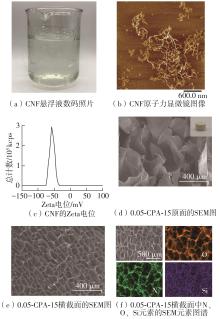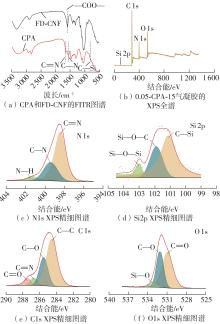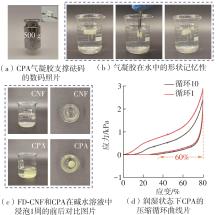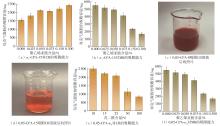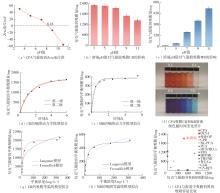| [1] |
LIU Y, KE Y, SHANG Q,et al .Fabrication of multifunctional biomass-based aerogel with 3D hierarchical porous structure from waste reed for the synergetic adsorption of dyes and heavy metal ions[J].Chemical Engineering Journal,2023,451(3):138934/1-15.
|
| [2] |
CHENG S, ZHAO S, XING B,et al .Preparation of magnetic adsorbent-photocatalyst composites for dye removal by synergistic effect of adsorption and photocatalysis[J].Journal of Cleaner Production,2022,348:131301/1-11.
|
| [3] |
QIAO A, CUI M, HUANG R,et al .Advances in nanocellulose-based materials as adsorbents of heavy metals and dyes[J].Carbohydrate Polymers,2021,272:11847/1-15.
|
| [4] |
GAO X, REN P, WANG J,et al .Fabrication of visible-light responsive Tio 2 @c photocatalyst with an ultra-thin carbon layer to efficiently degrade organic pollutants[J].Applied Surface Science,2020,532:147482/1-10.
|
| [5] |
WANG K, LIU X, TAN Y,et al .Two-dimensional membrane and three-dimensional bulk aerogel materials via top-down wood nanotechnology for multibehavioral and reusable oil/water separation[J].Chemical Engineering Journal,2019,371:769-780.
|
| [6] |
NASROLLAHZADEH M, SAJJADI M, IRAVANI S,et al .Green-synthesized nanocatalysts and nanomate-rials for water treatment:current challenges and future perspectives[J].Journal of Hazardous Materials,2021,401:123401/1-24.
|
| [7] |
刚恺悦,张宝浩,马宁,等 .基于静电作用选择性吸附染料的超分子凝胶剂[J].精细化工,2022,39(11):2328-2336.
|
|
GANG Kaiyue, ZHANG Baojie, MA Ning,et al .Supramolecular gels for selective adsorption of dyes based on electrostatic interaction[J].Fine Chemicals,2022,39(11):2328-2336.
|
| [8] |
GUO J, ZHOU S, MA X,et al .Regenerated cellulose/polyethyleneimine composite aerogel for efficient and selective adsorption of anionic dyes[J].Separation and Purification Technology,2024,330:125480/1-14.
|
| [9] |
YU J, TIAN S, YAO A,et al .Compressible polydopamine modified pomelo peel powder/poly(ethyleneimine)/k-carrageenan aerogel with pH-tunable charge for selective removal of anionic and cationic dyes[J].Carbohydrate Polymers,2024,323:121377/1-17.
|
| [10] |
MA X, ZHAO S, TIAN Z,et al .MOFs meet wood:reusable ragnetic hydrophilic composites toward efficient water treatment with super-high dye adsorption capacity at high dye concentration[J].Chemical Engineering Journal,2022,446(1):136851/1-9.
|
| [11] |
QIN W, LI M X, ZHANG Y,et al .High capacity and selective adsorption of congo red by cellulose-based aerogel with mesoporous structure:adsorption properties and statistical data simulation[J].International Journal of Biological Macromolecules,2024,259(1):129137/1-15.
|
| [12] |
PARALE V G, KIM T, CHOI H,et al .Mechanically strengthened aerogels through multiscale,multicompositional,and multidimensional approaches:a review[J].Advanced Materials,2024,36(18):2307772/1-47.
|
| [13] |
庄杰,徐朝阳 .纤维素基气凝胶吸附性能的研究进展[J].高分子材料科学与工程,2022,38(3):144-150.
|
|
ZHUANG Jie, XU Chaoyang .Advances in the adsorption properties of cellulose-based aerogels[J].Polymeric Materials Science and Engineering,2022,38(3):144-150.
|
| [14] |
DAS R, LINDSTROM T, SHARMA P R,et al .Nanocellulose for sustainable water purification[J].Chemical Reviews,2022,122(9):8936-9031.
|
| [15] |
欧阳志宇 .戊二醛-聚乙烯亚胺/羧甲基壳聚糖荷电纳滤膜的制备及性能研究[D].南京:南京理工大学,2019.
|
| [16] |
XU H, ZHANG Z, JIANG W,et al .Multifunctional amphibious superhydrophilic-oleophobic cellulose nanofiber aerogels for oil and water purification[J].Carbohydrate Polymers,2024,330:121774/1-12.
|
| [17] |
WANG Z, HE Y, WANG C,et al .A moisture-absorbing cellulose nanofibril-based foam via ambient drying for high-performance dehumidification[J].Chemical Engineering Journal,2024,486:150063/1-9.
|
| [18] |
WU N, YANG Y, WANG C,et al .Ultrathin cellulose nanofiber assisted ambient-pressure-dried,ultralight,mechanically robust,multifunctional Mxene aerogels[J].Advanced Materials,2023,35(1):2207969/1-12.
|
| [19] |
HU X, ZHANG S, YANG B,et al .Preparation of ambient-dried multifunctional cellulose aerogel by freeze-linking technique[J].Chemical Engineering Journal,2023,477:147044/1-10.
|
| [20] |
李方,雷春发,陈港 .基于抄纸法制备羧甲基改性高强纤维素膜及性能研究[J].造纸科学与技术,2021,40(1):23-28.
|
|
LI Fang, LEI Chunfa, CHEN Gang .Preparat-ion of carboxymethyl-modified high-strength cellulose membranes based on paper copying method and study of their properties[J].Paper Science and Technology,2021,40(1):23-28.
|
| [21] |
ZHU P, YU Z, SUN H,et al .3D printed cellulose nanofiber aerogel scaffold with hierarchical porous structures for fast solar-driven atmospheric water harvesting[J].Advanced Materials,2024,36(1):2306653/1-9.
|
| [22] |
QIU C, LI Y, LIU H,et al .A novel crosslinking strategy on functional cellulose-based aerogel for effective and selective removal of dye[J].Chemical Engineering Journal,2023,463:142404/1-10.
|
| [23] |
LI D, SUN L, YANG L,et al .Adsorption behavior and mechanism of modified pinus massoniana pollen microcarriers for extremely efficient and rapid adsorption of cationic methylene blue dye[J].Journal of Hazar-dous Materials,2024,465:133308/1-15.
|
| [24] |
LOREVICE M V, CLARO P I C, ALEIXO N A,et al .Designing 3D fractal morphology of eco-friendly nanocellulose-based composite aerogels for water remediation[J].Chemical Engineering Journal,2023,462:142166/1-14.
|
| [25] |
LI B, ZHAO Y .Facile synthesis and ultrastrong adsorption of a novel polyacrylamide-modified diatomite/cerium alginate hybrid aerogel for anionic dyes from aqueous environment[J].International Journal of Biological Macromolecules,2023,253(5):127114/1-14.
|
| [26] |
DU N, HUANG L, XIONG Y,et al .Micro-mechanism insights into the adsorption of anionic dyes using quaternary ammonium-functionalised chitosan aerogels[J].Carbohydrate Polymers,2023,313:120855/1-17.
|
| [27] |
ZENG X, ZHU J, ZHANG G,et al .Molecular-level understanding on complexation-adsorption-degradation during the simultaneous removal of aqueous binary po-llutants by magnetic composite aerogels[J].Chemical Engineering Journal,2023,468:143536/1-16.
|
| [28] |
LEE J, MATHUR S, SHEN S,et al .MoSe2 nanoflowers for highly efficient industrial wastewater treatment with zero discharge[J].Advanced Science,2021,8(23):2102857/1-8.
|
| [29] |
VARAMESH A, ABRAHAM B D, WANG H,et al .Multifunctional fully biobased aerogels for water remediation:applications for dye and heavy metal adsorption and oil / water separation[J].Journal of Hazardous Materials,2023,457:131824/1-18.
|
| [30] |
XIA N N, WU Q, BI S L .Ultra efficient removal of heavy-metal ions and dyes using a novel cellulose-based three-dimensional network[J].Cellulose,2024,31(6):3747-3761.
|
